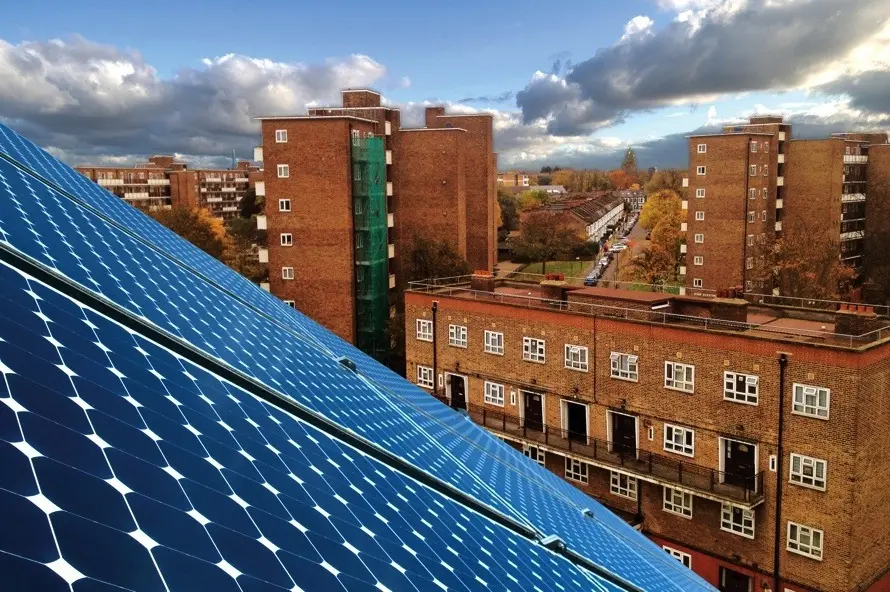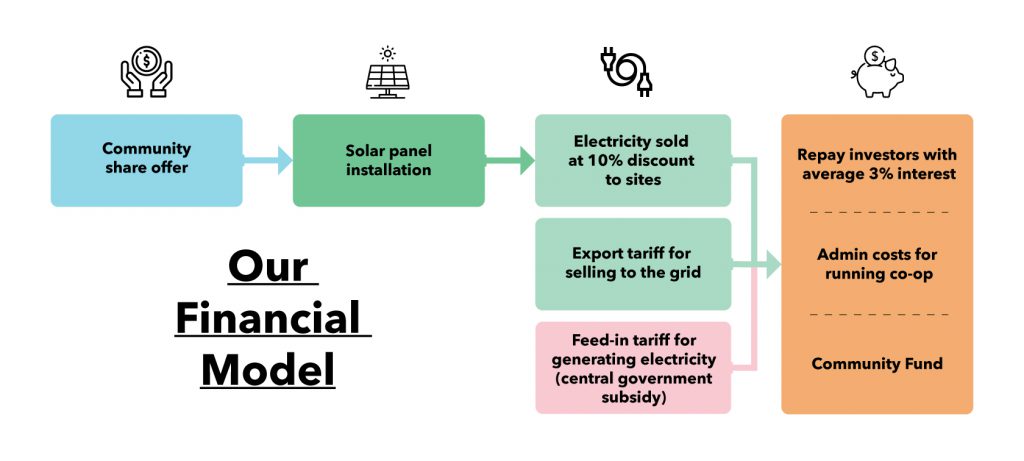To follow up our recent FAQ on home solar installation, we turn our focus to the questions you may have about how solar can be used by residents in blocks of flats
For example, for a block of flats there will be various agreements in place between leaseholders, freeholders (the owner or owners of the whole block), and other relevant parties such as managing agents. Because a roof is shared, it is very likely that any individual resident or leaseholder wanting to install solar panels will need the approval of the freeholder and agreement of the fellow leaseholders in the block.
In addition, if solar PV panels are installed on the roof of your block, the electricity generated may be used by residents as well as in communal areas such as stairwells and lifts. It is not always obvious whether the electricity generated can be used by residents directly, so this is another issue to clarify.
Nonetheless, don’t dismiss the idea of advocating for the use of solar in your block of flats. If any initial hurdles can be solved, there are important benefits:
- They have the potential to lower your energy bills or service charges, where the electricity generated is used to provide power for communal areas or within residents’ homes.
- Generating electricity via solar PV panels is a clean and renewable source of energy, so you will be reducing harmful emissions and future-proofing the block.
- As more low-carbon technologies are introduced – such as heat pumps, batteries, electric vehicle charging, etc., solar power can complement and maximise these future opportunities for your block to meet new Green targets and combat climate change.
- If you take a shared approach to installing solar panels – for instance by creating a community energy organisation along with your neighbours or joining with an existing organisation such as those supported by Repowering London – you can enjoy the excitement of working along with others to make positive change.
So, on with the questions and answers to give you everything you need to know about making solar power a reality for your flat or block.
Q1. Are solar panels a suitable option for my block?
There is an approach to energy efficiency and low-carbon upgrades in domestic settings known as “fabric first”. This approach encourages investment earmarked for energy upgrades to be initially focused on improving the fabric of the building first, so that the amount of energy required to maintain comfort levels in your block and home is reduced – regardless of how the energy is generated. Though this may not be the right approach in all cases it is generally a good rule of thumb. With this in mind, our advice is that you should consider installing solar panels only after improving the overall energy efficiency of your building.
A well-insulated building will often be able to make the best use of clean electricity generated by solar PV panels. There is little point in installing a solar PV system to create more electricity than you would otherwise need if your block and homes were more energy efficient.
If you are starting out on a solar installation project, it may be worthwhile to consult retrofit assessors and architects alongside solar experts and engineers to assess the suitability of the building. You should also consider how solar PV panels could work alongside other upgrades and identify if any other improvements may be a better initial investment.
Q2. Where should the electricity be used?
Depending on who will ultimately own the solar panels and who pays the electricity bill, it may be better to use the electricity generated by the solar panels in the building than export it to the National Grid – in other words, to generate what you need and not more. In the current energy market and policy landscape, the price of buying electricity from the Grid is more expensive than selling to the Grid. Therefore, directly using the electricity is a better financial decision than selling to the Grid. Indeed, the revenue generated if you were to sell to the Grid may not be enough to cover the costs of installation. This means that if your block does not have a high usage for communal power, then solar may not be the best option.
Using the electricity to power communal systems and appliances is likely to be easier and simpler than to power residents’ homes. This is because it is much easier and cheaper if the electricity generated is feeding one meter, e.g. communal heat or services. If your block has a communal heating system, it may be a good opportunity to explore combining solar panels with a ground source heat pump or other communal heating system powered by electricity.
To assess the options for using electricity within residents’ homes, you will need to understand how electricity is currently distributed in your building. The freeholder or building manager should have this information. Depending on the electrical distribution system, it may be possible to explore your options for using the electricity directly in residents’ homes. The two main ways that this is done currently are Energy Local or a more hardware and tech-based solution such as Sol Share.
Q3. Do I need permission to install panels?
In a block of flats you can own your home but not your roof, so whether you can install solar panels may not just be your own decision. You can usually find out about roof ownership in your deed or lease agreement.
If you live on the top floor of a block of flats, or in some blocks if you live on any floor, you might have access to the roof but require a license for alteration to install any solar panels. This can be a simple process, and free from your freeholder, but it can also have a fee associated with it. In any case, you should double-check your deed or lease agreement and ask your freeholder and/or building manager where relevant, so that you fully understand what permissions and agreements you may need to install solar panels. You should also ask your installer company for advice and guidance on this.
Q4. Will I need planning permission to install panels?
It is always important to check your local planning rules before considering installing solar panels, especially so if your block is a listed building or you are in a conservation area. You may need to appoint a planning consultant to support your project.
Solar panels are often permissible under permitted development rights (PDRs), but it does depend on the building and the installation process. PDRs allow certain upgrades or amendments to be carried out without requiring a full planning application process. For solar panels, PDRs may be applicable if certain conditions are met, such as (please note this is not an exhaustive list):
- The panels will not protrude more than 0.2 metres beyond the plane of the wall or the roof slope.
- The highest part of the solar PV is not higher than the highest part of the roof (excluding any chimney).
- The solar PV is, so far as practicable, sited so as to minimise its effect on the external appearance of the building, and the amenity of the area.
For the full list of conditions see the legislation: The Town and Country Planning (General Permitted Development) (England) Order 2015.
Q5. Is my roof suitable?
Unfortunately, not all roofs are suitable for solar PV panels. The location of the building, the orientation of the roof, the condition of the roof, whether the roof is flat or pitched/sloped, shaded by nearby tall buildings or trees, and the available space (many blocks host building systems and pipework on the roof, for example) are all important factors that will have an impact on feasibility. The solar panels will need sufficient sunlight to be most effective and you will need a sufficiently large system for your generation requirements.
It is possible to install on either flat or pitched roofs, but flat roofs tend to be more straightforward. In any case, you will need to confirm that the roof is able to handle the extra weight of the panels when installed. A solar installer can advise on this point, or a surveyor can inspect the roof and advise on any upgrades that may need to be made. Roof upgrades may provide a good opportunity to install solar panels – the necessity of the upgrade will reduce costs, e.g. scaffolding fees.
Assessing the viability of solar panels for your block will likely be a multi-stage process. Finding a competent solar installer will be a good place to start and they can guide you through the process.
Q6. What are the options for paying for an installation?
There are many options to finance rooftop solar on blocks of flats, but the first thing to understand is how much the installation will cost, how could this be repaid and over what time period, and then you can assess what financial model best meets your needs.
At Repowering London we have installed solar panels using a community owned model on many blocks. Using this model, the upfront capital costs are covered by raising finance from the community and electricity is then provided via a Power Purchase Agreement, generally at a discount to the current tariff. Get in touch if you would like us to assess whether this could be an option for your block.
It may be the case that leaseholders will need to contribute financially. This can be offset with cheaper bills or cheaper service charges, but you need to work carefully with an installer to understand the finer details of how much money you could save, and therefore the payback period of any installation. There are also grants available for low-carbon upgrades, but you will need to check if your block and context makes you eligible for this funding.
The freeholder could also provide the money, either through using reserve or sinking funds if feasible or through taking out a private loan that is repaid through service charges. Whether upgrades like this can be made will depend on the specific consents within Lease Agreements, and of course would require agreement of all leaseholders.
Q7. What will I need to consider during the installation?
Panels will be installed on the roof, but components of the overall system may need to be installed in the building. For example, an ‘inverter’ may need to be installed that will convert the electricity generated by the panels into usable electricity for your building and/or homes. Cabling will also be required through the building, which can be disruptive while it is being installed. The more cabling required, the more expensive the upfront capital costs will be. This is one of the reasons why having one meter to transport the generated electricity is easier; it requires less cabling.
It is likely that scaffolding will be required to install the panels. Again, this can be disruptive to residents so it is important to include everyone in the process and ensure communication of each stage is effective. Scaffolding can also be one of the more expensive elements of the total cost. This is why, if suitable and feasible for your building and context, it is always better to add solar installation on to other upgrades (e.g. roof upgrades or other energy efficiency measures) so that you only need to pay for scaffolding once to install all desired measures.
Please note: This guide is about installation of solar photovoltaic (PV) systems. In these systems, photons from the sun are absorbed by the panels and in turn release electrons, which results in a flow of direct current. This is then converted into alternating current by an inverter for safe use as an electricity source in the home. These should not be confused with solar thermal panels, which use collectors to absorb heat from the sun into a fluid, which is then transferred to a specialist hot water cylinder that can provide water heating for the home. You can learn more about solar thermal systems here.
We are here to help. If you are interested in exploring solar potential for your block, or want to learn more about improving the energy efficiency of your block, please get in touch


